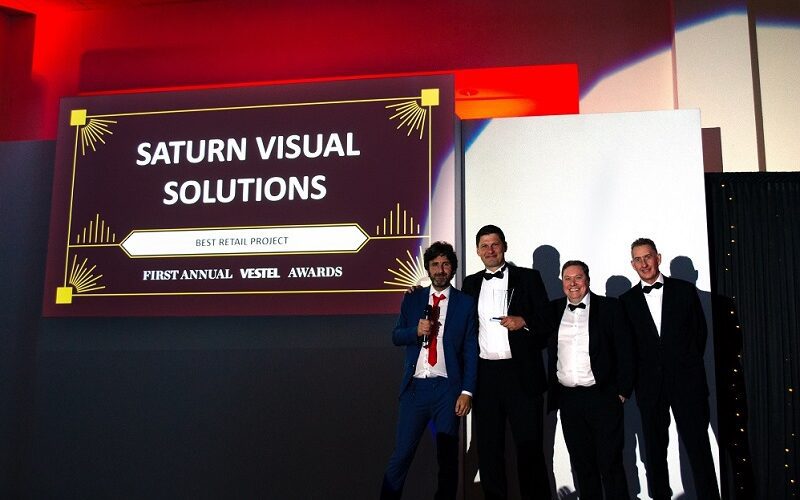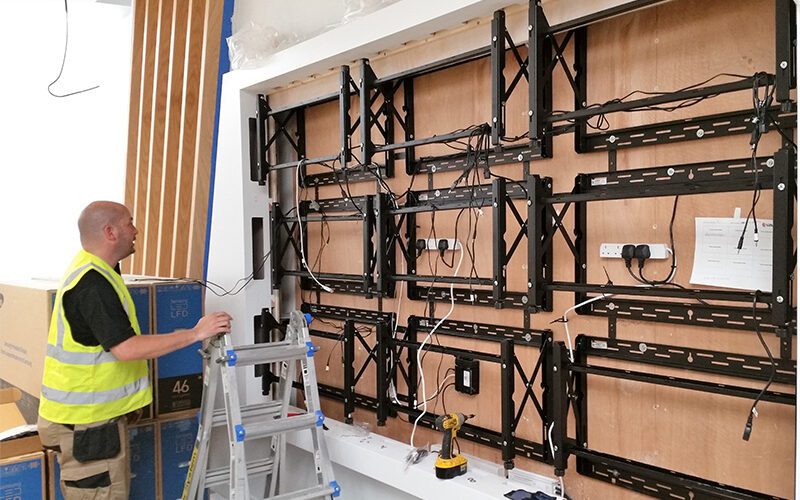The History of Digital Signage
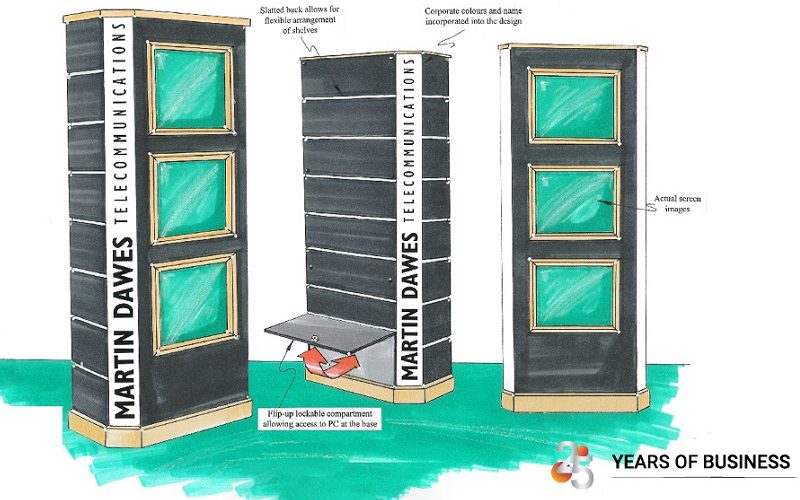
This year Saturn Visual Solutions celebrates its 25th anniversary of being in business. As our industry hasn’t been around much longer than we have, we thought we’d look at the history of digital signage and how it’s evolved over time.
When did ‘signage’ start?
Humans have been creating ‘signs’ for millennia, with the earliest known cave paintings thought to date back around 64,000 years.
We don’t know if they were purely decorative, or if they served a purpose, but we know that over time, signs started to be used to mark significant locations or to provide directions.
In modern times, people started to use lights to illuminate signs, making them easier to see at night and from a distance, and from this we progressed to full-motion video screens.
Major milestones in the 1960s-80s
Although digital signage didn’t exist until the late 1990s, some major milestones were reached during the second half of the 20th century that paved the way for it:
- 1968: Hewlett-Packard developed the first LED display
- 1972: Philips’ Video Cassette Recorder (VCR) launched to consumers
- 1976: JVC’s Video Home System (VHS) launched
- 1978: LaserDisc, an analogue optical disc format, launched
- 1987: Sony D-1, first digital videotape format, introduced
Within just a few decades, video recording technologies progressed from analogue to early digital media, while video players became small enough – and affordable enough – for most British homes to own a VCR by the end of the 1980s.
Baby steps into digital signage
During this same period, the first video wall, on-screen, and interactive displays started to appear in commercial settings.
This included:
- Videos of catwalk shows replayed via VCR in top-end fashion outlets
- Interactive digital kiosks used as automated teller machines (ATMs) by banks
- First video walls constructed by placing CRT televisions in a grid
As early as 1984, the Canadian grocery chain Loblaws started to use primitive digital signage to play training videos, in part thanks to the lower cost of video recorders by that time.
The digital revolution of the 1990s
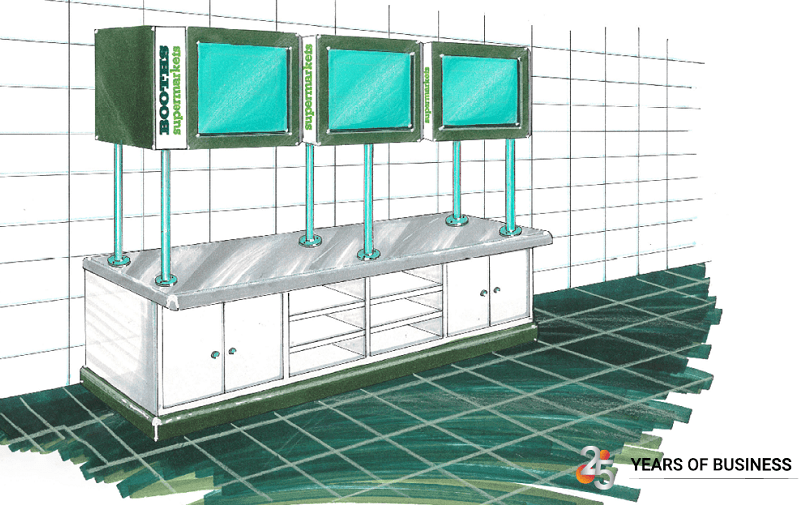
Sketch of historical retail digital signage from the 1990s
- The 1990s brought about the digital revolution. In the space of a decade or so, we saw the arrival of:
- Flatscreen TVs (launched by Fujitsu in 1997)
- Home computers
- Mobile phones (and BlackBerry from 1999)
- Dial-up internet
- DVD
- Analogue media formats (VHS tape) was used to play pre-recorded footage on CRT (cathode ray tube) screens in commercial settings.
- Early content management software (CMS) systems started to be developed (late 1990s)
Playing video more easily
As video formats progressed from analogue to digital, allowing more footage to be stored on smaller, more durable optical discs (and eventually on hard disk drives), it became viable for businesses to use televisions and DVD players for commercial purposes.
Although the first CMS (content management system) was launched in 1990, it took a while for digital media players to become smaller and more lightweight, with more sophisticated software.
Commercial displays were still referred to as video walls, until 1992, when a security guard in a UK shopping centre first used the term ‘digital signage’ (reportedly because he didn’t know the correct name for them). It’s a good way to describe the collection of digital technologies and screens that together powers modern-day video displays – so it’s no surprise that it’s stuck for over 30 years now.
Digital signage in the 2000s
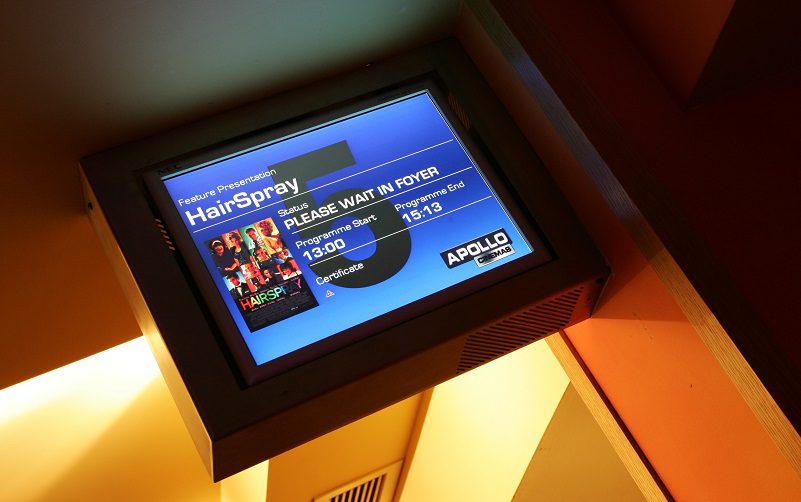
Historical digital signage image – screen from 2007
We’re now arguably at the most important era now, as this is where the most change has happened. So let’s look at some of the biggest landmark developments in the history of digital signage in the early ‘noughties’.
- Broadband internet in the early 2000s
- Evolution of the modern CMS
- LED wall displays
- Commercial production of touchscreen displays
- Commercial production of screen enclosures (for outdoor use and freestanding displays)
- Growing use of interactive payment kiosks
- The first tablet computers (iPad was launched in 2010)
The creation of a market/industry
As the technology used for domestic television sets started to evolve and screens became thinner, space became less of an issue and more businesses started to use them. Manufacturers began to appreciate the size of the potential market for digital signage hardware. As a result, the range of commercial hardware available began to evolve.
Key developments at this time were:
Interactive touchscreens
The proliferation of interactive touchscreens in retail environments, fast-food restaurants and all sorts of other settings has put digital signage at the customer’s fingertips at the moment of purchase, giving retailers new ways to upsell/cross-sell.
Cloud-based CMS software
Networked digital signage – via wireless internet and a media player – means that businesses can now update what’s playing on their displays from anywhere in the world.
LED Walls
Imagery was taken off self-contained screens and put onto displays without a protective screen – which are made using LEDs tiles – making them more flexible.
The last ten years
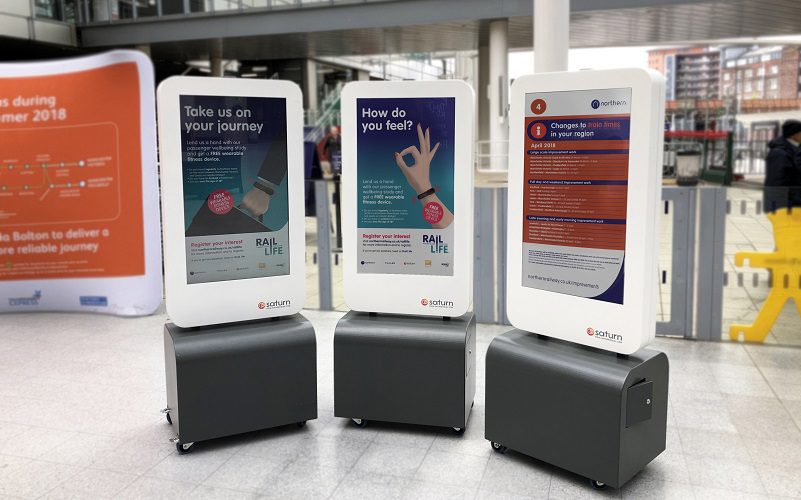
Mobile battery-powered digital signage displays from 2018
The evolution of digital signage continues and there have been a number of key developments over the last ten years. These include:
- Integration of data/internet/social media with CMS systems
- High bright screens
- Shelf-edge digital displays
- Curved LED wall and OLED displays
- Transparent displays
- Retail analytics
- Development of RFID & increasing usage in commercial setting (e.g. retail stores)
- AR/VR/motion sensors applied to digital signage
- Mobile and battery-powered displays
The evolving market
In terms of the history of digital signage, the last ten years could be described as the golden era.
The industry has been experimenting with the ‘art of the possible’ and evolving what can be done with hardware and software.
As such, there is now digital signage hardware for almost every type of situation and application. Displays are now available thinner, smaller, bigger, transparent, mobile, brighter, battery-powered, and increasingly, more energy efficient.
Software-wise, the key developments are the integration of third-party data/information and displays, so displays can update automatically or introduce new information on screen. Two examples of this are:
Social media interaction
Live digital video walls can incorporate elements of social media, for example displaying curated posts that contain a specific hashtag, to allow for real-time interaction by audience members.
Augmented reality
Augmented reality (AR) superimposes digital elements over live video footage of the real world, creating immersive advertising displays with excellent levels of engagement.
Displays are also now being used to gather data via touchscreen displays, motion sensors, and AI, giving businesses more information about their customers and their preferences so they can continuously improve.
Shaping the future of digital signage
As we move through the 21st century, what lies ahead for digital signage? Ever-increasing bandwidth and higher resolutions, standalone renewable energy sources like built-in solar panels, spherical displays, AR and 3D…?
The technology is changing all the time and it’s hard for businesses that aren’t at the heart of the industry to keep up with all the developments and options available.
As such, if you’re evolving your existing digital signage estate or setting one up for the first time, it’s important to speak to a professional. They’ll have a good awareness of what hardware and software the industry loves and hates, and why that is.
If you’re looking for advice, why not speak to a company that’s been around since the very beginning of the digital signage industry and is still at the forefront of all the technological changes taking place now? Just fill in the form below or give us a call on 0161 222 0706.
Ready to make an impact?
Get in touch now for competitive prices, good advice, & slick project delivery

